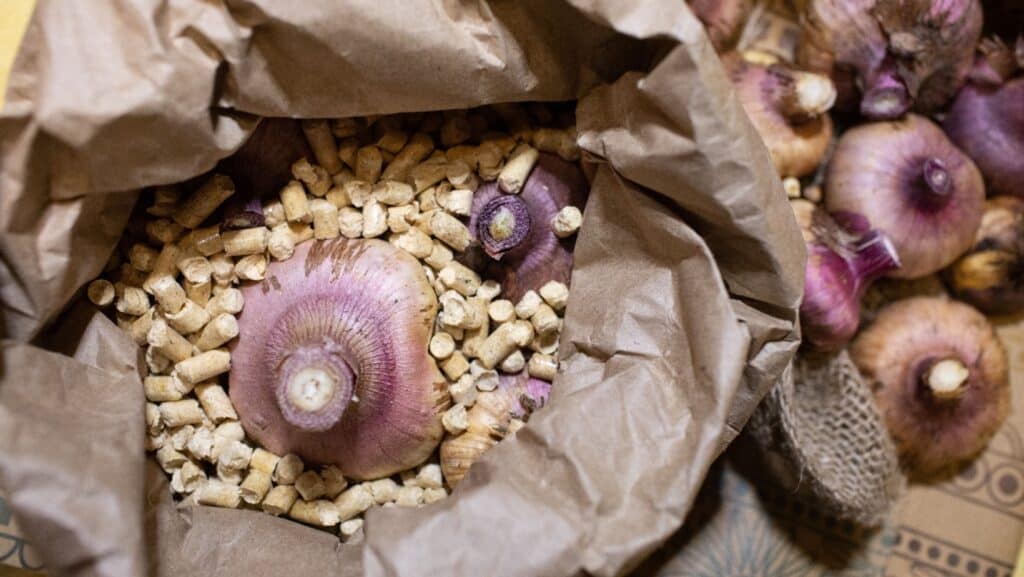7 Steps To Storing Tender Bulbs and Rhizomes Over Winter
Tender bulbs and rhizomes, like dahlias, cannas, and begonias, add vibrant colors and unique textures to gardens during the warm months. However, these plants cannot survive cold winters in most regions, as they are not frost-hardy. To enjoy their beauty year after year, proper storage during the colder months is essential. This guide will walk you through the steps of storing tender bulbs and rhizomes over winter, ensuring they remain healthy and ready for replanting come spring.
What Are Tender Bulbs and Rhizomes?

Before diving into storage methods, it’s important to understand what tender bulbs and rhizomes are.
- Tender bulbs include plants like dahlias, tuberous begonias, and gladiolus. These underground storage organs help the plant store nutrients, but they are susceptible to freezing temperatures.
- Rhizomes are horizontal underground stems from which plants like cannas and calla lilies grow. Like bulbs, they store food for the plant and need protection from frost.
Let’s Do It Right!

Now that you know what you’re dealing with, let’s explore how to store them effectively.
1. Preparing for Winter Storage: Timing Is Key

The first step in storing tender bulbs and rhizomes is knowing when to dig them up. Timing is critical because harvesting too early can affect the plant’s ability to store energy for the winter, while waiting too long could expose them to frost damage.
- Wait for the first frost: Most gardeners wait for the first light frost to signal that it’s time to dig up the bulbs or rhizomes. A light frost will often kill the top foliage, signaling that the plant is entering dormancy. This frost won’t yet harm the underground bulbs or rhizomes.
- Observe foliage: Once the foliage turns yellow or begins to die back, it’s a good indicator that the plant has stored enough energy in its bulb or rhizome to survive the winter.
2. Digging Up Tender Bulbs and Rhizomes

Once the plant has been signaled to go dormant, it’s time to dig up your tender bulbs or rhizomes.
- Use a garden fork or spade: To avoid damaging the bulbs or rhizomes, use a garden fork or spade to gently lift them from the soil. Start a few inches away from the base of the plant and work your way around, carefully loosening the soil.
- Shake off excess soil: After lifting the bulbs or rhizomes, shake off as much loose soil as possible. Be gentle to avoid damaging the delicate storage organs. If they are covered with too much dirt, use your hands to remove it carefully.
- Avoid washing the bulbs: It may be tempting to wash off all the soil, but leaving some dirt on the bulbs is actually beneficial. Washing can introduce too much moisture, which could lead to rot during storage.
3. Curing and Drying the Bulbs

Once you have dug up the tender bulbs or rhizomes, the next step is to cure and dry them. This is an essential step to ensure that they don’t rot or develop mold during storage.
- Dry in a well-ventilated space: Place the bulbs or rhizomes in a cool, dry, and well-ventilated area for about one to two weeks. A garage, shed, or covered porch can work well. Make sure the area is out of direct sunlight and has good airflow.
- Remove excess dirt and roots: After the bulbs have dried, gently brush off any remaining soil. Remove any dead roots or foliage but be careful not to damage the bulbs or rhizomes themselves.
- Check for rot or disease: Inspect each bulb or rhizome for signs of rot, mold, or disease. Discard any that appear soft, damaged, or unhealthy, as they could spoil other stored bulbs.
4. Packing for Storage

Once cured, the tender bulbs and rhizomes are ready for packing. Proper packing helps ensure that they maintain the right level of moisture without becoming too wet or too dry.
- Use breathable materials: Store bulbs in breathable materials such as paper bags, cardboard boxes, or mesh bags. Avoid plastic bags, as they can trap moisture, leading to mold or rot.
- Layering with medium: Many gardeners use dry peat moss, vermiculite, or sawdust to store bulbs. These materials help to absorb excess moisture and provide insulation. Layer the bulbs in the box or bag with the storage medium, making sure they don’t touch each other directly.
- Labeling: If you’re storing multiple types of bulbs, label them to avoid confusion in the spring.
5. Choosing the Right Storage Location

Location is crucial when storing tender bulbs and rhizomes over winter. You’ll need a spot that is cool, dry, and protected from temperature fluctuations.
- Cool, but not freezing: Ideally, the storage area should remain between 40°F and 50°F (4°C to 10°C). Basements, unheated garages, or insulated sheds are often ideal locations. Avoid places that freeze, like outdoor sheds without insulation.
- Dry conditions: The storage area should be dry but not so dry that the bulbs desiccate. You want to strike a balance between preventing excessive moisture and keeping the bulbs from drying out completely.
- Good ventilation: Air circulation is important to prevent mold and rot. Avoid closed containers or overly damp environments.
6. Periodic Maintenance

While your tender bulbs and rhizomes are in storage, it’s important to check on them periodically throughout the winter months.
- Check moisture levels: If the bulbs or rhizomes are starting to shrivel, it’s a sign that the environment may be too dry. You can lightly mist them with water to maintain the right moisture balance.
- Look for rot or disease: Discard any bulbs that have developed signs of rot or mold to prevent them from spreading to the others.
- Repack if necessary: If the storage medium becomes too damp, replace it with fresh, dry material.
7. Preparing for Replanting in Spring

Once winter is over and the soil has warmed up in the spring, it’s time to bring your tender bulbs and rhizomes out of storage.
- Reintroduce to warmth: Bring the bulbs into a warmer space a few weeks before planting to help wake them from dormancy.
- Inspect for damage: Before planting, inspect the bulbs and rhizomes one last time for any signs of rot or damage.
- Replant in well-drained soil: Once the danger of frost has passed, replant the bulbs in well-drained soil, water them, and watch them return to life for another growing season.
Conclusion

Storing tender bulbs and rhizomes over winter is an essential task for gardeners who want to preserve their favorite plants year after year. By following the steps outlined in this guide, you can ensure that your bulbs and rhizomes stay healthy and ready to bring color and beauty to your garden for many seasons to come. Proper timing, careful digging, curing, packing, and storage will help protect your plants during their winter dormancy, allowing them to thrive once the weather warms again.
The Most Foolproof Indoor Plants for People Who Struggle to Keep Plants Alive

Bringing greenery into your home can have a transformative effect on your living space, adding life, color, and even improving air quality. However, for many people, keeping houseplants alive can be a daunting challenge. If you’ve ever felt like you have a “black thumb,” you’re not alone. Fortunately, there are several indoor plants that are incredibly resilient and low-maintenance, making them perfect for those who have struggled with plant care in the past. This article will explore the most foolproof indoor plants that can thrive even with minimal attention, ensuring that everyone can enjoy the benefits of houseplants, regardless of their gardening experience.
READ: The Most Foolproof Indoor Plants for People Who Struggle to Keep Plants Alive
Plan a Trip to the Top Botanical Gardens in the U.S.! An Unforgettable Journey Through America’s Finest Flora

Visiting botanical gardens is a delightful way to immerse yourself in the beauty of nature, learn about diverse plant species, and find peace in meticulously designed landscapes. The United States boasts some of the most impressive botanical gardens, each offering unique experiences and horticultural wonders. In this guide, we will explore the best botanical gardens across the country, highlighting their distinctive features and must-see attractions.
Join Us

Join us on this empowering journey as we explore, celebrate, and elevate “her story.” The Queen Zone is not just a platform; it’s a community where women from all walks of life can come together, share their experiences, and inspire one another. Welcome to a space where the female experience takes center stage. Sign up for our newsletter so you don’t miss a thing, Queen!







